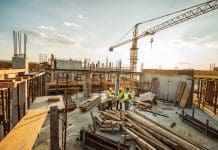The August 2022 ONS figures have been released, showing the second consecutive monthly growth in the industry with an increase of 0.4%
Following the upward revised increase to 0.1% this July, the August 2022 ONS figures show an increase of 0.4% in volume terms, a second consecutive display of monthly growth.
The 0.4% in construction output in August 2022 represents an increase of £60m in monetary terms compared with July 2022, with three out of the nine sectors seeing an increase on the month.
August 2022 is the second highest monthly value in level terms (£15,011m), with May 2022 remaining at the highest level since records began in January 2010 (£15,035m).
As repair and maintenance work took a back seat, new work carried the momentum of growth
The increase in monthly construction output in August 2022 came solely from an increase in new work (1.9%), as repair and maintenance saw a decrease (2.0%) on the month.
Anecdotal feedback from businesses consulted as part of the data gathering suggested that the high price of construction materials was having an impact on repair and maintenance projects, putting them on hold as the supply chain continues to struggle in light of international conflict.
The cost-of-living crisis was blamed for some businesses and households spending less on repairs for similar reasons, whilst new work- largely costed before the latest price increases- carried on, although firms had to absorb the difference.
At the sector level, the main contributors to the increase seen in August 2022 were infrastructure, private industrial, and private housing new work, which increased 5.3%, 4.3%, and 1.7%, respectively.
Over the summer, industrial and private commercial works showed the most growth
In the three months to August 2022, private industrial, private commercial and private housing new work increased by 11.9% (£208m), 4.2% (£225m) and 3.9% (£394m), respectively.
Alongside the monthly increase, construction output saw a slight increase of 0.1% in the three months to August 2022; this came solely from an increase seen in new work (1.6%) as repair and maintenance saw a decrease (2.4%), this is the tenth consecutive period of growth in the three month on three month series, however it is the slowest rate of growth since the three months to October 2021 that saw a fall of 0.7%.
New work growth is encouraging, say industry voices
Clive Docwra, managing director of property and construction consultancy McBains, said:
“The moderate growth witnessed in August shows the construction industry is holding firm during a difficult period.
“It’s encouraging that the rise in output is being driven by new work, and the fact that infrastructure, private industrial and private housing new work increased by 5.3%, 4.3% and 1.7%, respectively will be a tonic to the industry.
“However, there are still bumps in the road to be negotiated. Material price inflation may be starting to fall, according to recent figures and from what our clients are telling us, but the cost of construction remains high and further volatility over the medium term can be expected as factors such as Russia’s invasion of Ukraine and the energy crisis bites harder.
“And despite the increase seen in private investment, the risk of recession and high interest rates means some investors are still holding the pause button until the economic picture becomes much clearer.”
Long term growth is harder to predict with the August 2022 ONS figures, given the UK’s economic instability
Beard Construction finance director Fraser Johns says:
“It is encouraging to see two consecutive months of growth during July and August – however small – in an increasingly challenging economy.
“The fact that the growth came from an increase in new work is a reminder that developers still have the confidence to commit to new schemes. This growth is sustainable if the sector continues to price jobs fairly and accurately, building in price fluctuations where necessary, rather than passing the risk down the supply chain.
“However, these positive trends could well be interrupted by the current volatility and uncertainty overhanging the wider UK economy.
“Material inflation seems to be calming down compared to earlier in the year but the rising cost of energy remains a concern.”
Supporting SMEs should be a priority in the face of the cost-of-living crisis
Stuart Law, CEO of the Assetz Group, said on the August 2022 ONS figures:
“The construction sector is among the industries that will be the hardest hit by the challenging economic environment.
“This is particularly significant for SMEs who are disproportionately impacted by exponential increases in the cost of materials, labour shortages, rising energy bills, supply chain issues and the looming threat of at least a modest recession driven by sharply rising interest rates. This instability is also aggravated by uncertainty in economic policy that has often failed to prioritise small and medium sized businesses. As a result, we do expect construction to slow materially into 2023 as this combination of further factors comes to bear on the market.
“While we have seen the UK construction industry welcome the new Energy Bill Relief Scheme from 1 October, the pressure will be on the Government to uphold long-term support for the sector in the face of steadily rising energy bills.
“Whilst macro-economic conditions can’t be easily solved, a key solution to this is supporting SMEs through innovative funding solutions so they can properly play their part in boosting construction, and most importantly, meeting the urgent need for new homes as we face a housing crisis in the UK. SMEs are agile and favourable when it comes to sustainable growth in the construction sector and through revitalising the SME sector, we can support companies that are pioneering innovative construction methods.
“Intervention couldn’t be more needed, particularly as high street banks are visibly pulling back funding due to decreasing risk appetite. Private investors already play a huge part in stimulating and mobilising the SME sector, but we need to consider the future of construction carefully and private investment needs to play a bigger part of supporting the sector going forward.”
The private sector is becoming a crutch for the industry
Dave Sheridan, executive chairman ilke Homes, commented:
“It’s becoming abundantly clear that the UK construction is increasingly relying on private house builders as a crutch for sector growth. The latest ONS data shows that August’s increase in monthly output resulted from an increase in new work, primarily from private sector house builders who saw output increase by 1.8%.
“Conversely, as the macro environment continues to pile on the pressure on the on the traditional stalwarts of construction industry, public sector house building fell yet again and repair and maintenance decreased by 2%, showing just how much the private sector is picking up the slack.
“The government has committed to boosting supply-side reform, but these changes in policy are yet to bear fruit for house builders. If the government is still serious about generating growth through stimulating supply-side reform then investing and incentivising innovative and sustainable technologies like MMC are essential in meeting the UK’s desperate need for housing.”

















